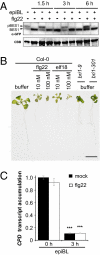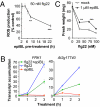Brassinosteroids inhibit pathogen-associated molecular pattern-triggered immune signaling independent of the receptor kinase BAK1
- PMID: 22087006
- PMCID: PMC3252947
- DOI: 10.1073/pnas.1109921108
Brassinosteroids inhibit pathogen-associated molecular pattern-triggered immune signaling independent of the receptor kinase BAK1
Abstract
Plants and animals use innate immunity as a first defense against pathogens, a costly yet necessary tradeoff between growth and immunity. In Arabidopsis, the regulatory leucine-rich repeat receptor-like kinase (LRR-RLK) BAK1 combines with the LRR-RLKs FLS2 and EFR in pathogen-associated molecular pattern (PAMP)-triggered immunity (PTI) and the LRR-RLK BRI1 in brassinosteroid (BR)-mediated growth. Therefore, a potential tradeoff between these pathways mediated by BAK1 is often postulated. Here, we show a unidirectional inhibition of FLS2-mediated immune signaling by BR perception. Unexpectedly, this effect occurred downstream or independently of complex formation with BAK1 and associated downstream phosphorylation. Thus, BAK1 is not rate-limiting in these pathways. BRs also inhibited signaling triggered by the BAK1-independent recognition of the fungal PAMP chitin. Our results suggest a general mechanism operative in plants in which BR-mediated growth directly antagonizes innate immune signaling.
Conflict of interest statement
The authors declare no conflict of interest.
Figures





Comment in
-
Brassinosteroids modulate plant immunity at multiple levels.Proc Natl Acad Sci U S A. 2012 Jan 3;109(1):7-8. doi: 10.1073/pnas.1118600109. Epub 2011 Dec 22. Proc Natl Acad Sci U S A. 2012. PMID: 22198764 Free PMC article. No abstract available.
References
-
- Shiu S-H, Bleecker AB. Plant receptor-like kinase gene family: Diversity, function, and signaling. Sci STKE. 2001;2001:re22. - PubMed
-
- De Smet I, Voss U, Jürgens G, Beeckman T. Receptor-like kinases shape the plant. Nat Cell Biol. 2009;11:1166–1173. - PubMed
-
- Boller T, Felix G. A renaissance of elicitors: Perception of microbe-associated molecular patterns and danger signals by pattern-recognition receptors. Annu Rev Plant Biol. 2009;60:379–406. - PubMed
-
- Li J, et al. BAK1, an Arabidopsis LRR receptor-like protein kinase, interacts with BRI1 and modulates brassinosteroid signaling. Cell. 2002;110:213–222. - PubMed
-
- Nam KH, Li J. BRI1/BAK1, a receptor kinase pair mediating brassinosteroid signaling. Cell. 2002;110:203–212. - PubMed
Publication types
MeSH terms
Substances
Grants and funding
LinkOut - more resources
Full Text Sources
Molecular Biology Databases

